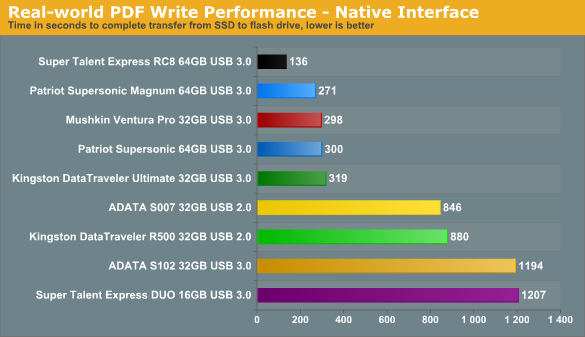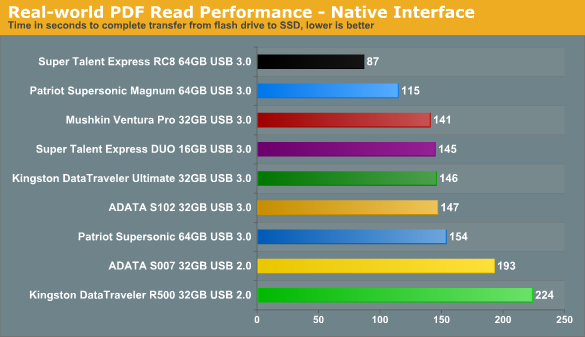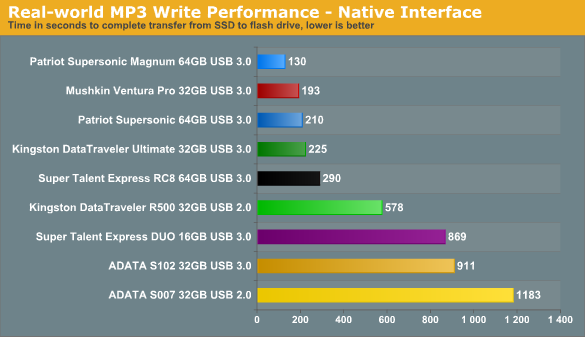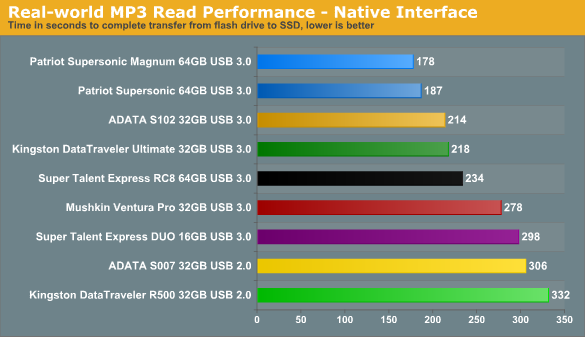USB 3.0 Flash Drive Roundup
by Zach Throckmorton on July 29, 2011 11:15 AM EST- Posted in
- Storage
- Kingston
- USB 3.0
- Patriot
- Gadgets
- ADATA
- Super Talent
- Flash Drive
- Mushkin
Real-world native interface comparisons
As described on the second page of this article, I performed a number of tests that reflect how I use flash drives. I am primarily a research scientist, and I also I love to listen to music and watch movies. Thus, flash drives in my possession are pressed into transporting three file types: small, compressible files like PDFs and office documents, MP3s, and DVD ISOs. If you are a programmer, you might be more interested in seeing how these drives fare with very small files of short pieces of code. If you are an astrophotographer, you might be interested in how flash drives handle RAW files that are hundreds of megabytes in size. As you can imagine, there are literally as many flash drive use patterns as there are folks who use flash drives, and testing them all simply is not feasible. That said, between these real-world timings and the synthetic benchmarks, you can make informed decisions when buying flash drives!

The Super Talent RC8 absolutely screams writing small, compressible files. I contacted both ADATA and Super Talent regarding the poor performance of the S102 and Express DUO, respectively, for this particular test. ADATA acknowledged the garbage collection algorithms of their S102 controller result in noticeable performance degradation during sustained writes of small files. They reported they'll be implementing new controllers in their S102 line of USB 3.0 flash drives.

The Super Talent RC8's lead is diminished but still present. If you frequently move lots of smaller files like PDFs and office documents, the RC8's the drive for you.

Patriot's Supersonic Magnum takes first place in sustained MP3 writes. The issue with the controllers of the ADATA S102 and Super Talent Express DUO continue to retard their sustained write performance of approximately 5MB file size MP3s. Also notice the Kingston R500 handily bests its USB 2.0 competitor from ADATA.

The Supersonic Magnum again produces the fastest MP3 transfer rates. If you're a mobile DJ, that's your drive!

Unsurprisingly, the four drives with the highest 100MB sequential write benchmarks in Iometer perform the best writing a single 4.2GB ISO file.

There's less than a 10% separation between the seven USB 3.0 flash drives for sustained single large file read. This chart vividly illustrates how much faster USB 3.0 can potentially be compared to USB 2.0, with the USB 3.0 drives performing more than 100% faster than their USB 2.0 counterparts. Note that we're nowhere near the theoretical transfer rate of USB 3.0 either, so future drives (and controllers) will likely be even faster.
These charts elucidate how superior Iometer synthetic benchmark performance of USB 3.0 flash drives translate into superior real-world performance. Super Talent's Express RC8 is particularly impressive in its ability to write many small, compressible files like PDFs and office documents. Writing many sub-1MB files is a pointed weakness of all flash drives, so the RC8's controller technology is aimed squarely at a glaring issue. And it hits it dead center!
The controller issue that afflicts the ADATA S102 and Super Talent Express DUO USB 3.0 flash drives during sustained smaller (i.e. <10MB) file sizes is a deal-breaker for me given my usage patterns. However, it's important to note that the performance degradation only occurs when transferring many files (the PDF and MP3 tests here each transfer thousands of files). This performance degradation does not occur when transferring a handful of files. You might or might not run afoul of their Achilles' Heel.
The question remains whether USB 3.0 flash drives outperform USB 2.0 devices when both are utilizing a USB 2.0 interface. Find out on the next page!










42 Comments
View All Comments
coyote2 - Saturday, August 6, 2011 - link
Are you talking about 6GB/s eSATA III?USB3 is so much faster than the last eSATA, I'd be surprised to hear it's "protocol overhead" could make it perform slower.
theangryintern - Friday, July 29, 2011 - link
I have the ADATA S102, got it a few months ago. So far I've been very happy with it. At home where I have a USB 3.0 controller card and an SSD boot drive, copies to and from the ADATA are screaming fast. At work, even on USB 2.0 it's still pretty fastPotablePots - Friday, July 29, 2011 - link
I was actually hoping that this article would look at portable application performance. I use a ton of portable application software and finding a flash drive that will give the best performance when running applications is something I could use AT's help on. Most of my portable software comes from PortableApps.com. I use mostly Portable Chrome and OpenOffice but also GIMP and Blender on occasion.Aikouka - Friday, July 29, 2011 - link
Zach, is it possible that you can list some value to help identify how much data you're transferring to these devices in the real world tests? For example, while I may copy PDFs to my thumb drives at times, I don't necessarily copy over hundreds of megabytes worth. I normally spend the most time waiting when I'm copying really large files to a thumb drive such as a movie I shot on my HD camcorder.Gigantopithecus - Saturday, July 30, 2011 - link
Hi Aikouka - The details of the real world scenario tests are on the second page. For the PDFs, the test copied 3,364 PDFs totaling 3.20GB. As I said, there are as many real-world usage scenarios as there are flash drive users! I personally, on a near daily basis, will copy hundreds, if not thousands, of PDFs onto a flash drive to perform a dump on a colleague's computer (hmm, that doesn't sound good - but you know what I mean, ha). That is if someone asks me about topics x, y, and z, I'll simply say read these, and give them a bunch of articles. I addressed your interest in large file transfers with the 100MB Iometer benchmark numbers and the real-world DVD ISO file read/write performance times. Those should give you a clear picture of which drives read and write bigger files, like those shot on your HD cam, the fastest.justcommenting - Friday, July 29, 2011 - link
Hey,I don't mean any offense, but I thought the writing style with this post was below normal Anandtech standards. The introduction skips details on what USB 1.1 changed that saw the widespread adoption and jumps around between discussing USB flash devices and USB hard disk devices without distinction between the two.
I appreciate the various graphs, but I don't think the author did a very good job of explaining why certain drives pulled ahead in various scenarios, why that might matter, etc. Instead, graphs felt tossed into pages with little more than a description of the picture underneath.
Like the pages before it, the conclusion is also a tough read due to general poor sentence / paragraph structure. I love Anandtech articles because of the highly technical content and the well-phrased, well-researched, and well-backed opinions put forth. I'd pay for it if I could, but preferably with stronger articles than this one. :)
Pozz - Saturday, July 30, 2011 - link
indeed and less exclamation marks would be a start :)still, very interesting article
MaximillianSterling - Friday, July 29, 2011 - link
Nice random U-M reference.Ah, the VERY long nights spent there. Although I preferred the Media Union.
Gigantopithecus - Saturday, July 30, 2011 - link
I hoped someone would catch that. ;) Lotta really long nights there, brother!Goi - Sunday, July 31, 2011 - link
I would've liked to see what controllers and NAND flash chips were being used in the different flash drives. I know some are using USB 3.0<->NAND flash bridge controllers, while others are using SSD controllers with a separate SATA<->NAND flash bridge, or perhaps using a NAND device with a SATA interface. It would be interesting to find out how these design decisions affect performance.